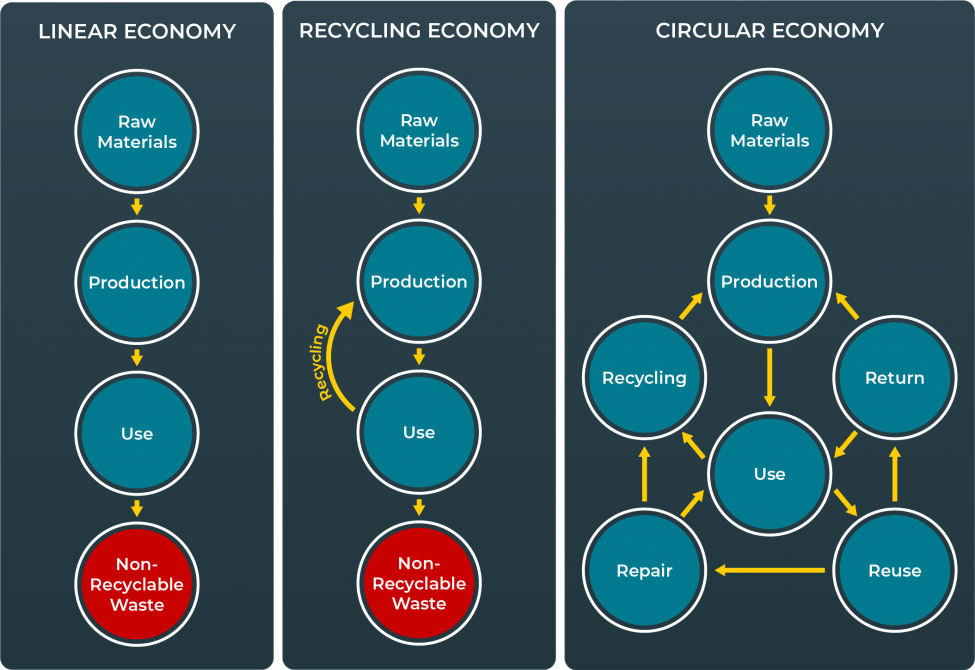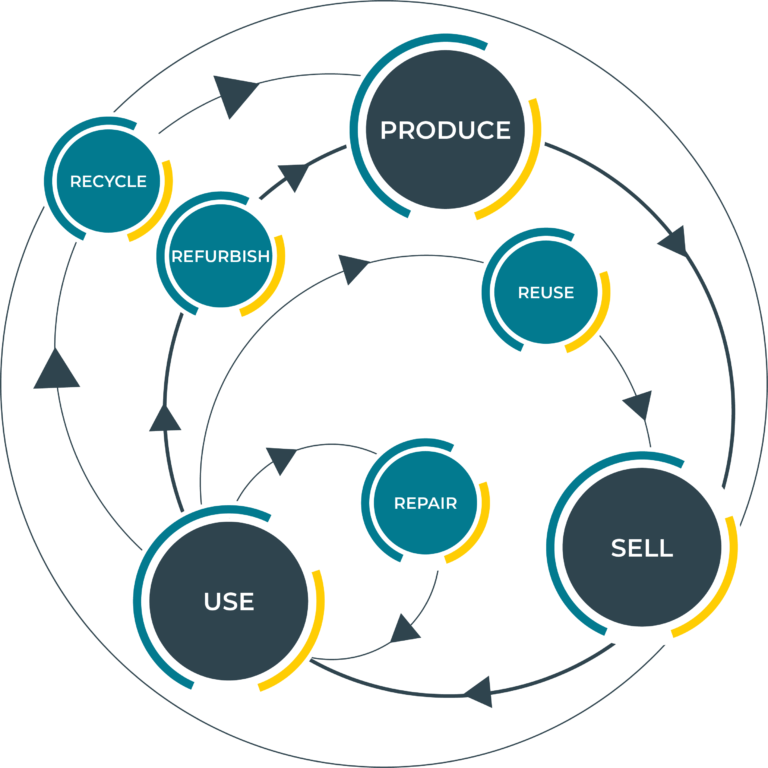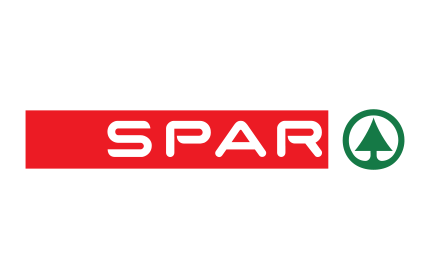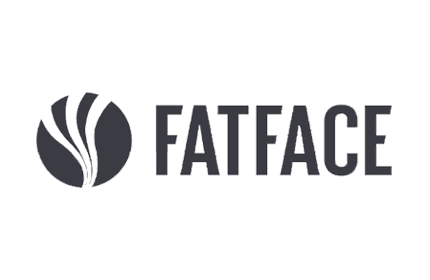Circular Economy | All you need to know
The circular economy moves away from the traditional “take-make-dispose” economic model to one that is regenerative by design. The goal is to retain as much value as possible from products, parts and resources to create a system that allows for long life, sharing, digitisation and resource recovery.
By applying these principles, companies can design out waste, increase resource productivity and decouple growth from natural resource consumption.
Our handy guide is designed to help you accelerate your transition towards the circular economy.
Contents
- What is a circular economy?
- How does a circular economy work?
- Benefits of adopting circularity
- Who invented the circular economy?
- Linear v circular economy
- What are the benefits of a circular economy?
- Key elements of circular business models
- Why do we need a circular economy?
- How do you implement a circular economy?
- What is Ecoveritas?
- What does Ecover?
- Ecoveritas’ services
What is a circular economy?
The circular economy is a systems solution framework that tackles global challenges like climate change, biodiversity loss, waste, and pollution.
The circular economy manifests economic models highlighting business opportunities where cycles dominate rather than linear processes. It is restorative and regenerative by design and aims to keep products, components, and materials at their highest utility and value at all times.
The circular economy is a term used to describe an alternative way of thinking and living for consumers and businesses. It is a model based on three key principles:
- Eliminating waste and pollution
- Keeping products and materials in circulation at their highest value
- Helping nature regenerate
Each principle encourages us to:
- Rethink and redesign the way things are made and used so that we waste less
- Make products for longevity and repairability, and to be easily disassembled for parts for remanufacturing or reuse at the end of their useful life
- Protect our environment by reducing the environmental impact of how we live
“The Circular Economy is an economic system that delivers better outcomes for people and the environment” – Ellen MacArthur Foundation (2022)
How does a circular economy work?
- Designs out waste and pollution
Circular economy designs out economic activities that negatively impact human health and natural systems. This includes the release of greenhouse gases, all types of pollution and traffic congestion.
- Keeps products and materials in use
Circular economy favours designing products for durability, reuse, remanufacturing, and recycling to keep materials circulating for as long as possible. It’s an economy that encourages many different uses for materials instead of just using them up.
- Regenerates living systems
A circular economy avoids the use of fossil fuels and non-renewable energy. Preserving and enhancing renewable resources returns valuable nutrients to the soil to support regeneration and actively improve the environment.
A way to transform our system
What will transform our throwaway economy into one where waste is eliminated, resources are circulated, and nature is regenerated?
The circular economy gives us the tools to tackle climate change and biodiversity loss while addressing important social needs.
It gives us the power to grow prosperity, jobs, and resilience while cutting greenhouse gas emissions, waste, and pollution.
Benefits of adopting circularity
The circular economy creates multiple economic, social, and environmental advantages, including:
- Reduction in the use of non-renewable resources and making better use of finite resources
- Reduction in greenhouse gas emissions by more sustainable management of materials
- Improved waste management to avoid waste polluting our natural environment and going to landfill
- Job creation in areas such as recycling, remanufacturing, and repair
- Increased customer loyalty by making the process of reusing, renting, or leasing a product easier. This, in turn, allows for a better understanding of consumer behaviour and therefore improves consumer satisfaction and experience.
Who invented the circular economy?
There was no single creator of the idea of a circular economy. The term is largely a 21st-century construct, but its principles were first discussed in the mid-twentieth century.
Kenneth Boulding’s The Economics of the Coming Spaceship Earth (1966), Herman Daly’s notion of a ‘steady-state economy’ from 1974, and Cradle to Cradle: Remaking the Way We Make Things (2002) by Michael Braungart and Bill McDonough are seminal publications on the topic.
Linear vs circular economy
The linear economy is the term for our current globalised economy in which we extract resources, manufacture products, use them, and then throw them away. It is based on mass production and consumerist lifestyles of short-life disposable products such as mobile phones, fashion items such as trainers and clothes, and luxury items such as washing machines and cars.

The linear economy thrived in the past because it offered high profits for manufacturers worldwide and low prices for consumers in developed nations.
However, this low-cost, high-profit model is only possible because the linear economy does not price the cost of the enormous waste, pollution, and carbon emissions built into the system.
Industry is often incentivised to waste, pollute, and emit, as they are rarely required to pay these actions’ full environmental or social costs.
If a price was put on social and environmental harms such as emissions or waste, and more circular and sustainable approaches were rewarded, there would be multiple improvements such as healthy ecosystems, safer working conditions, and high-quality environmental goods and services.

What are the benefits of a circular economy?
A circular economy offers various social, economic, and environmental benefits.
By maximising the lifetime of our products and materials and designing out waste, circularity reduces our demand for raw materials and the environmental impact of obtaining them.
And using recycled raw materials will, in most cases, use less energy when manufacturing products, reducing carbon emissions.

If done right, the circular economy shrinks harmful activities such as carbon emissions, air pollution, and toxicity exposure. It increases positive actions such as habitat restoration, renewable energy, and air cleaning.
The circular economy also offers social benefits, particularly in low-income economies, because integrating informal waste pickers into formal waste collection provides job security and fair wages.
Circularity also promises to deliver substantial economic benefits. Scaling up reuse, repair, remanufacturing, and recycling creates millions of jobs and stimulates innovation. Capturing and reusing critical materials such as rare earth metals helps make the economy more resilient to global supply chain shocks and ensures the world has the materials to create the renewable energy infrastructure it needs.
Key Elements of Circular Business Models
Elements of the circular economy manifest in various activities, including:
- Waste prevention: avoiding waste generation and reducing waste production at the source
- Reuse: allowing other people to benefit from an item after the original owner has finished using it
- Repair and refurbishment: fixing something which is broken or replacing parts to make something like-new
- Remanufacture: the process of remaking or rebuilding an item using the original or replacement component parts, some of which may have been used in other similar items
- Renting and servitisation: paying to hire a product or for the service
- The sharing economy: making products available for others to use when you are not
- Industrial symbiosis: waste or surplus material from one process is the feedstock for another
Why do we need a circular economy?
The world’s population is expected to peak at 10bn in 2050. Our resources, the earth’s raw materials, are not limitless. As a result, global labour and raw material costs increase.
Circular economy business opportunities can offer new ways to mitigate these risks to allow businesses to grow and diversify. In a circular economy, products and materials keep circulating in a high-value state of use, through supply chains, for as long as possible.
For this reason, “making things last” is a moral, environmental and economic imperative.
How do you implement a circular economy?
The shift to a circular business model is a radical, restorative, and regenerative approach to business that requires a fundamentally different way of thinking. Many new models, materials and products will come from entrepreneurs, but existing organisations also play a critical role by rethinking current strategies.

Design for the future
Account for the systems perspective during the design process, to use the right materials, design for an appropriate lifetime, and design for extended future use.
Rethink the Business Model
Consider opportunities to create greater value and align incentives that build on the interaction between products and services.
Circular Economy Ideas
Incorporate Digital Technology – Use digital, online platforms and technologies that provide insights to track and optimise resource use, strengthen connections between supply chain actors, and implement circular models.
Team Up to Create Joint Value
Work together throughout the supply chain, internally within organisations, the public sector, and communities to increase transparency and create joint value.
Strengthen and Advance Knowledge
Develop research, structure knowledge, encourage innovation networks and disseminate findings with integrity.
What is Ecoveritas?
The easiest and most comprehensive way to manage environmental data and reporting needs.
What does Ecoveritas do?
Ecoveritas is an environmental compliance data specialist that provides a range of tools and expertise to brands, retailers, and supply chains to minimise the environmental impact of their packaging efficiently.
To meet the complex challenges of managing environmental compliance reporting, Ecoveritas offers a unique combination of consulting, data and software that helps companies around the globe take the next step in their sustainability journey.
Our team takes a fresh approach to the environmental compliance market by adding years of supply chain and technical development expertise to an experienced environmental data team to provide SaaS-based services.
Our mission is to make it easy for companies to understand their obligations, get compliant and respond appropriately through reduction, substitution, and recycling.
Ecoveritas’ services
- Extended Producer Responsibility Data Management & Reporting
- Plastic Tax Data Management & Reporting
- EPR Horizon Scanning
- EPR Consulting
- UK Packaging EPR – Ecoveritas can help you prepare your packaging for EPR
Navigating environmental legislation is time-consuming. For businesses operating across numerous countries, the issue is even more complex.
Speak to one of our advisors on +44 (0)1865 721375 or email info@ecoveritas.com to find out how we can help you take the complexity out of environmental compliance!























